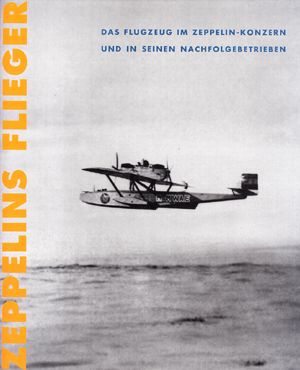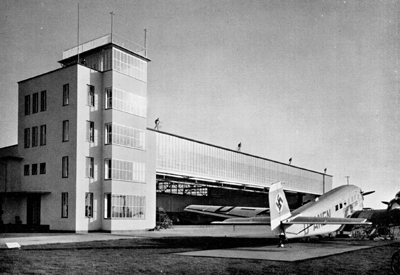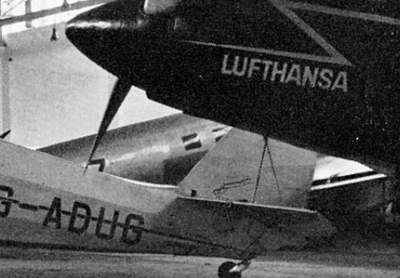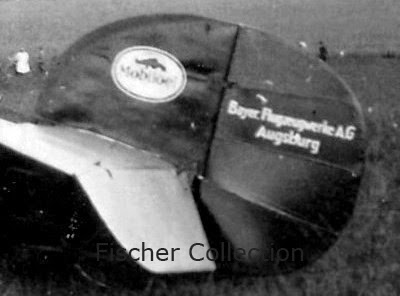
Edited by Wolfgang Meighörner, Zeppelin Museum Friedrichshafen, Ernst Wasmuth Verlag, Thübingen & Berlin/Zeppelin Museum, Friedrichshafen, Germany, 2006, ISBN 3-8030-3316-0. Illustrated, hardcover, published in German.
Cover image © by Ernst Wasmuth Verlag, 2006.
Published to complement an exhibition at the Zeppelin Museum in Friedrichshafen, Germany, Zeppelins Flieger: Das Flugzeug im Zeppelin-Konzern und in seinen Nachfolgebetrieben [Zeppelin's Aviators: Aircraft In The Zeppelin Group And In Its Successor Firms] is a compendium of highly intriguing essays by a variety of authors. Traditionally, the word "Zeppelin" has become a metaphor for large, silver airships and, inevitably, the image of airship LZ 129 Hindenburg as it perishes near its mooring mast in Lakehurst, New Jersey, in May 1937. Somewhat less immediate, perhaps, might be the association of Zeppelin with the airship bombing raids over England during the First World War.
Far more unknown, however, is the fact that Ferdinand Graf von Zeppelin and the Luftschiffbau Zeppelin [Zeppelin Airship Manufacturing] plant were also involved in numerous aircraft-related undertakings, following humble beginnings as early as 1899. Among the most notable were, perhaps, Ferdinand Graf von Zeppelin's role in establishing Claudius Dornier's Dornier Metallbau [Dornier Metal Construction], later to be renamed Dornier Flugzeugwerke [Dornier Aircraft Manufacturing Plant], or Luftschiffbau Zeppelin's license production of aircraft and rocket components during the Second World War. The extent of the subject matter is astonishingly substantial.
In spite of the fact that a truly comprehensive study of all of Luftschiffbau Zeppelin's aviation activities would undoubtedly merit far more than just one book, Zeppelins Flieger is a truly formidable and wide-ranging study. At 320 tightly printed pages, and with 255 often striking images, Zeppelins Flieger is quite literally a heavy tome. The narrative is subdivided into 16 individual essays, which together form a fairly cohesive record of Zeppelin's non-airship ventures. Among the authors are a number of distinguished German aviation history specialists, such as Karl Kössler, Lutz Budrass, Günter Frost, or Hans-Peter Dabrowski. Each essay is completed by a list of explanatory notes and sources. By far the major part of Zeppelins Flieger covers the years up to 1945, with only comparatively few pages addressing events following the Second World War and up to today.
The content of some of the essays is stunning. Jürgen Bleiber's examination of the revolutionary E.4/20 airliner, for example, is riveting, not least due to the photo content. Equally captivating are Günter Frost's look at Dornier's aircraft of the 1920s, or Hans-Peter Dabrowski's descriptions of Zeppelin's affiliation with the Messerschmitt Me 323 and Luftschiffbau Zeppelin's later projects, such as the ZSO 523 transport, the Fliegende Panzerfaust, the Zeppelin Rammer, and the Zeppelin airliner. Further examples are Peter M. Grosz and Michael Schmeelke's Die Riesenflugzeuge des Zeppelin-Konzerns im Ersten Weltkrieg [Giant Aircraft Of The Zeppelin Group In The First World War], Lutz Budrass' look at Rohrbach and Dornier, or Karl Kössler's brief exploration of the evolution of Dornier's Do 17 design.
Among the most noteworthy essays is Christa Tholander's Ausländische Arbeitskräfte in der Zeit des Zweiten Weltkriegs bei den Dornier-Werken 1939–1945 [Foreign Labour At Dornier's Plants During The Second World War 1939-1945]. Tholander's contribution is based on a doctoral thesis, and it is exemplary that this drastic and all too often quietly excluded topic is an integral part Zeppelins Flieger. One of Tholander's most unexpected revelations is that Dornier explored all legal means at its disposal to improve the living conditions of the Ostarbeiter [eastern workers] in its service.
Zeppelins Flieger can be recommended without hesitation. It is a detailed and expertly researched publication with very high production standards. Its appeal may conceivably be limited only by the fact that it has been published in German. Nonetheless, the fact that Peter Schmoll's various German language works on certain aspects of Messerschmitt's aircraft production have been translated and compiled into the English-language Nest Of Eagles (Classic Publications/Ian Allan Publishing Ltd., England, 2010) leaves room for hope that Zeppelins Flieger, too, might one day be granted a competent English translation.






































